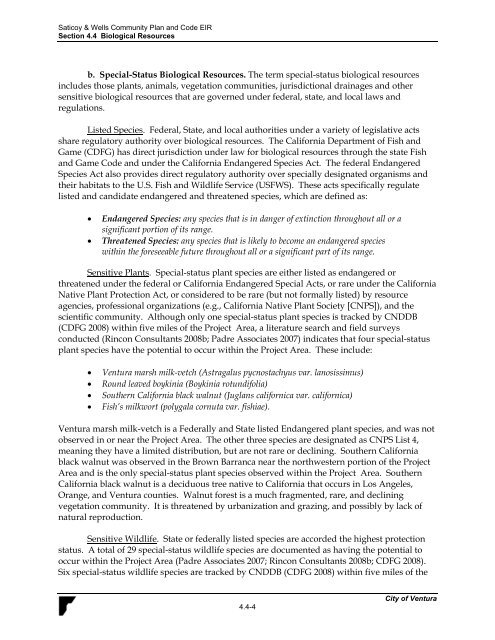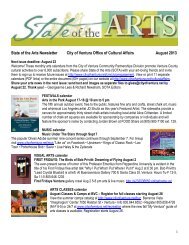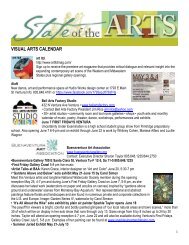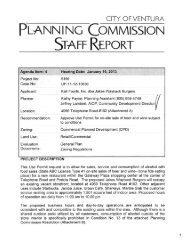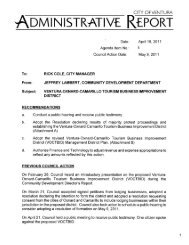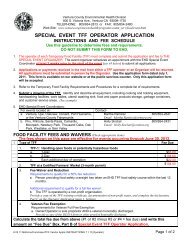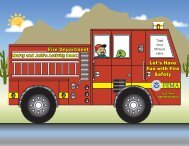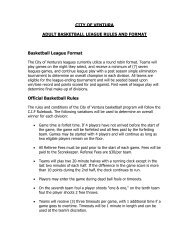Saticoy & Wells Community Plan & Development ... - City Of Ventura
Saticoy & Wells Community Plan & Development ... - City Of Ventura
Saticoy & Wells Community Plan & Development ... - City Of Ventura
Create successful ePaper yourself
Turn your PDF publications into a flip-book with our unique Google optimized e-Paper software.
<strong>Saticoy</strong> & <strong>Wells</strong> <strong>Community</strong> <strong>Plan</strong> and Code EIRSection 4.4 Biological Resourcesb. Special-Status Biological Resources. The term special-status biological resourcesincludes those plants, animals, vegetation communities, jurisdictional drainages and othersensitive biological resources that are governed under federal, state, and local laws andregulations.Listed Species. Federal, State, and local authorities under a variety of legislative actsshare regulatory authority over biological resources. The California Department of Fish andGame (CDFG) has direct jurisdiction under law for biological resources through the state Fishand Game Code and under the California Endangered Species Act. The federal EndangeredSpecies Act also provides direct regulatory authority over specially designated organisms andtheir habitats to the U.S. Fish and Wildlife Service (USFWS). These acts specifically regulatelisted and candidate endangered and threatened species, which are defined as:• Endangered Species: any species that is in danger of extinction throughout all or asignificant portion of its range.• Threatened Species: any species that is likely to become an endangered specieswithin the foreseeable future throughout all or a significant part of its range.Sensitive <strong>Plan</strong>ts. Special-status plant species are either listed as endangered orthreatened under the federal or California Endangered Special Acts, or rare under the CaliforniaNative <strong>Plan</strong>t Protection Act, or considered to be rare (but not formally listed) by resourceagencies, professional organizations (e.g., California Native <strong>Plan</strong>t Society [CNPS]), and thescientific community. Although only one special-status plant species is tracked by CNDDB(CDFG 2008) within five miles of the Project Area, a literature search and field surveysconducted (Rincon Consultants 2008b; Padre Associates 2007) indicates that four special-statusplant species have the potential to occur within the Project Area. These include:• <strong>Ventura</strong> marsh milk-vetch (Astragalus pycnostachyus var. lanosissimus)• Round leaved boykinia (Boykinia rotundifolia)• Southern California black walnut (Juglans californica var. californica)• Fish’s milkwort (polygala cornuta var. fishiae).<strong>Ventura</strong> marsh milk-vetch is a Federally and State listed Endangered plant species, and was notobserved in or near the Project Area. The other three species are designated as CNPS List 4,meaning they have a limited distribution, but are not rare or declining. Southern Californiablack walnut was observed in the Brown Barranca near the northwestern portion of the ProjectArea and is the only special-status plant species observed within the Project Area. SouthernCalifornia black walnut is a deciduous tree native to California that occurs in Los Angeles,Orange, and <strong>Ventura</strong> counties. Walnut forest is a much fragmented, rare, and decliningvegetation community. It is threatened by urbanization and grazing, and possibly by lack ofnatural reproduction.Sensitive Wildlife. State or federally listed species are accorded the highest protectionstatus. A total of 29 special-status wildlife species are documented as having the potential tooccur within the Project Area (Padre Associates 2007; Rincon Consultants 2008b; CDFG 2008).Six special-status wildlife species are tracked by CNDDB (CDFG 2008) within five miles of the4.4-4<strong>City</strong> of <strong>Ventura</strong>


